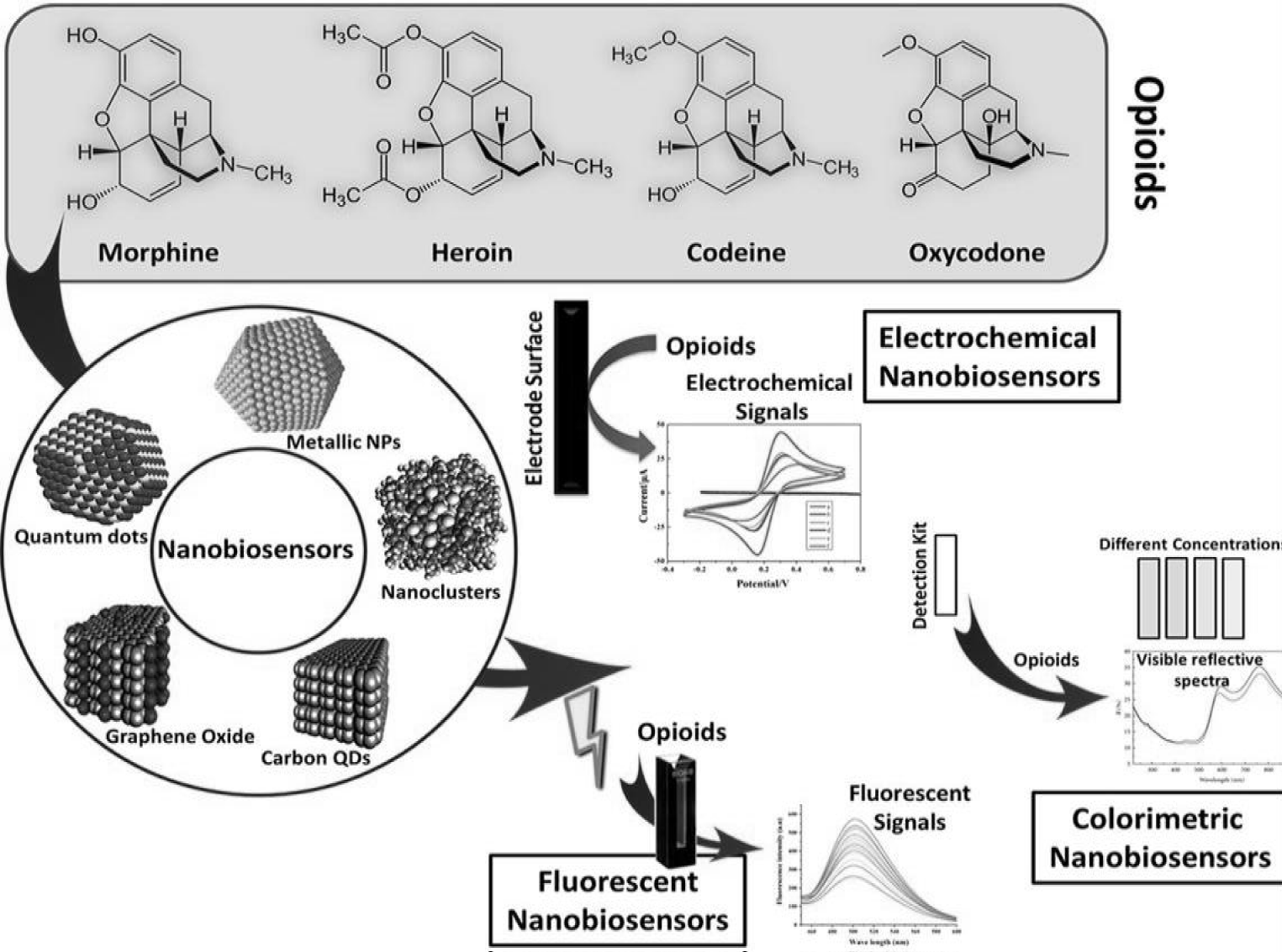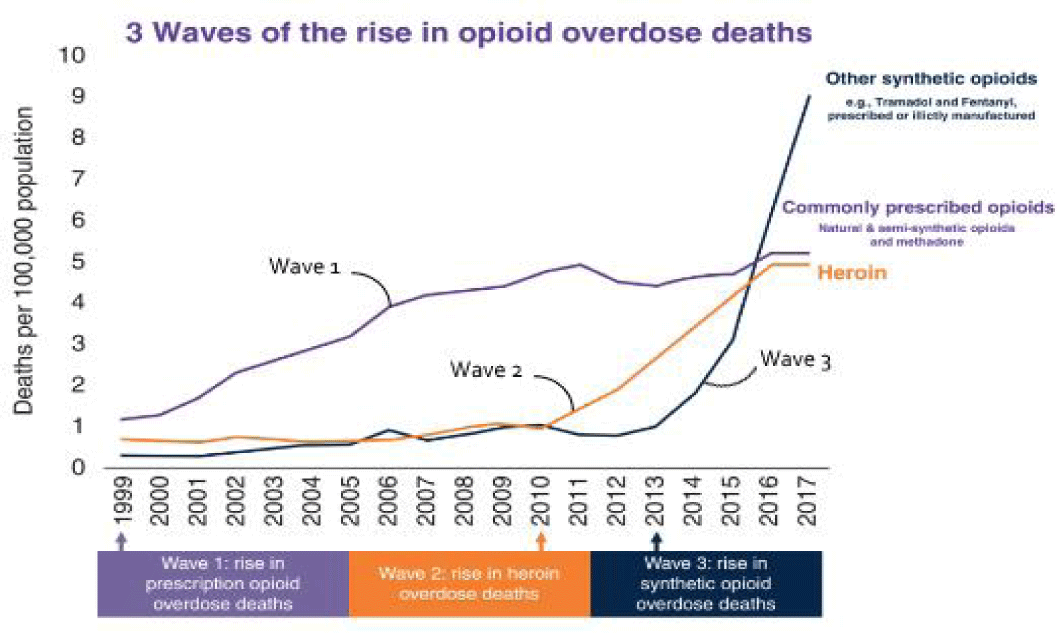Biology Group . 2023 June 16;4(6):1046-1056. doi: 10.37871/jbres1767.
General Review on Opioids
Areej D Al-Onizi1, Bashaer A Abu-hasabu1, Dalal N Al-Hwaiti1, Ro’aa M Al-Ali1, Norah M Al-Madani1 and Haddad A El Rabey1,2*
2Bioinformatics Department, Genetic Engineering and Biotechnology Research Institute, University of Sadat City, Sadat City 32897, Egypt
- Opioids
- Receptors
- Alkaloids
- Detection
- Classification
Abstract
Opioids are widely utilized by the public as both legal and illegal substances. Opiates, particularly heroin, are among the most widely used illicit narcotics and still account for the majority of seizures globally, despite the development of Novel Psychoactive Substances (NPS), particularly new fentanyl derivatives. The article gives a general review of opiates' pharmacology, analgesic action, and classification. It discussed how they might be abused by the general public and in the event of tampering. Because of the hazards of accidents linked to opiate use and dependence, opiates are furthermore closely monitored in workplace drug testing programs around the world. Also it covered analytical techniques for opiate detection in biological fluids. In the modern era, substance abuse has emerged as a global epidemic. Opium and its derivatives are second only to cannabis in terms of global consumption among illegal narcotics.
Introduction
Opioids are any synthetic or semi-synthetic derivatives of opium, which were initially made from extracts of the opium poppy. Since its introduction, the term "opioid" has come to mean any substance, natural or synthetic, that has morphine-like effects. Opioids also include naturally occurring "morphine-like" compounds that bind to the same opioid receptor sites in the brain and opioid antagonists. They have been used for thousands of years and have significantly reduced human misery. The two main uses in the past have since the dawn of time, humans have relied on opioids for both the treatment of human suffering and their psychotropic properties, including the treatment of pain and diarrhea. Since they are such powerful analgesics, opioids remain a mainstay in the treatment of pain. Opioids aren't used enough to treat people with moderate to severe pain, though. In the modern era, substance abuse has emerged as a global epidemic [1].
Among people whom heavy opioids include strong opioids were prescribed those who have complained from pain and diarrhea. Comorbid conditions, and other overdose of its derivatives are second only to cannabis in terms of global consumption among illegal narcotics. Opium usage is widely accepted in many Asian countries, leading some laypeople and even some doctors assume that it can treat dyslipidemia and lower blood pressure and glucose risk factors [2].
The aim of many medical practitioners still think that patients' lives are shortened by painkillers. This case suggests that the ethical justification of double effect is frequently used to support the use of decorations in extreme situations. The goal of this study is to update the information on the impact of opioids used to control illness symptoms on patient survival that is currently available in recently published literature.
Structure of Opioids and Classifications
Structure
Opioids are regarded as a group of substances produced from the poppy plant. Some opioids are peptides, whereas others are alkaloids have an aromatic ring (Figure 1) and a nitrogen atom that is charged at pH neutral are the two structural characteristics that are shared. Alkaloids (like morphine) have several fused rings, resulting in a T-shaped structure. Peptides (like enkephalin) have an aromatic ring as one of the side chains and a positively charged nitrogen atom at their amino terminus. Some opioids naturally come from plants, like the opium poppy (opiates). Others in contrast, are artificial or "made by humans." Opioids include drugs like morphine, tramadol, codeine (found in products like Panadeine Forte, Nurofen Plus, and Panadeine), and heroin. Some recently created psychoactive opioid substances include acetyl fentanyl, furanyl- fentanyl, U-47700, MT-45, O-dimethyl tramadol, and U-47700. The structure of opioids is shown in figure 1 [3] as follow:
Opioids can be divided into three categories: natural, semi-synthetic, and synthetic, depending on where they come from and whether they interact with target receptors. The called after morphine, as it binds with it), (named after vas deferens, the tissue from which it is isolated), and (Named after ketocyclazocine, as it binds with it) receptors are three kinds of GPCRs (G-Protein Coupled Receptors) that opioids can bind to and become activated [3].
Classification of opioids
Opioids are categorized based on their nature as shown in table 1. Frequency of occurrence, or how they interact with particular receptors [3]. The Following is a classification by occurrence:
Natural opioids: Opioids that are naturally derived include codeine, morphine, and opium. Natural opioids, commonly known as opiates, are derived from the Papaver somniferous plant's seed pods as shown in figure 2 [1]. They originate from the covering that surrounds the seeds, to be more precise. This coating has been removed from the poppy seeds found in morning muffins, so there is very little chance that they could cause even a little intoxication [3].
Semi-synthetic opioids: Opioids that are semi-synthetic are both natural and synthetic. They are produced in a lab using codeine or morphine, and are stronger than the plants that originally produced them. The semi-synthetic opioid class (Table 1) includes heroin, oxycodone (OxyContin, Percocet), hydrocodone (Vicodin), hydromorphone (Dilaudid), and oxymorphone (Opana) [3].
| Table 1: Classification of opioids by derivation [3]. | ||
| Naturally Occurring | Semisynthetic | Synthetic |
| -Phenanthrene -Morphine -Codeine -Thebaine -Benzylisoquinoline -Papaverine -Noscapine |
-Morphine -Diacetylmorphine -Dihydromorphine -Dihydrohydroxymorphine -Thebaine derivatives -Buprenorphine -Oxycodone |
-Morphinans -Levorphanol -Nalbuphine -Phenyl heptylamines -Methadone -I-Alpha-acetyl methadol (LAAM) -Propoxyphene -Phenylpiperidine -Alfentanil -Alphapointe -Fentanyl -Ketobemidone -Meperidine -Remifentanil -Sufentanil |
Synthetic opioids: in a laboratory, synthetic opioids (Table 1) are created from scratch. Fentanyl (Actiq, Duragesic, Sublimaze), methadone (Dolophine, Methadose), and tramadol (Ultram) are three instances [3]. The classification of opioids are shown as follow.
- Opioid Receptors: Your body is capable of producing a variety of endorphins. They are G Protein-Coupled Receptors (GPCRS) which act as mediators for human response to neuro transmitters and drugs. Three kinds of opioid receptors are present, while each of the three types has a specific function in your body, they also all contribute to pain relief: Mu Opioid Receptors (MORs) result in euphoric emotions and promote positive reinforcement. Along with physical dependence, constipation, and respiratory depression, they also cause these side effects. KORs, or kappa opioid receptors, have a sedative effect. They are also to blame for the stress or depressive symptoms that frequently follow prolonged opiate usage. Delta Opioid Receptors (DORs) support anxiety reduction [4]. One of the major systems of the pain-reward interface, which is made up of four peptides, is made up of endogenous opioids (Table 2). The receptors have been shown as follow:
- Mode of Action: The primary effect of opioids on the neurological system is thought to be their presynaptic action to limit neurotransmitter release [5]. The three different kinds of opioid receptors exist, according to recent developments in the molecular biology of these receptors. All of them utilize G-protein to connect to intracellular mechanisms. The actions of endogenous opioid peptides, such as -endorphin (which has cell bodies in the hypothalamus), enkephalins, and dynorphins (which are widely distributed throughout the brain and have high concentrations in reward- and pain-related neurocircuits), are mimicked by opioid drugs. The three transmembrane G protein coupled opioid receptors and consequent alterations in second messenger gene transcription are responsible for the behavioral effects of opioids [5]. The painkilling and euphoric effects of opioids, as well as a variety of other behavioral and physiological impacts, are all brought on by the opioid receptors.
| Table 2: Effects associated with the main types of opioid 1receptors [4]. | ||||
| Endogenous | Receptors | |||
| µ | δ | k | ORL1 | |
| β-endorphin | +++ | +++ | +++ | - |
| Leu-enkephalin | + | +++ | - | - |
| Met-enkephalin | ++ | +++ | - | - |
| Dynorphin | ++ | + | +++ | - |
| Nociceptin(or orphanin FQ) | - | - | - | +++ |
| ORL1 Opioid Receptor Like type 1, - no affinity, +weak affinity, ++moderate affinity, +++ strong affinity. | ||||
According to pharmacological research, endorphin naturally occurring opioid peptide, interacts preferentially with m receptors, whereas enkephalins engage with d -receptors and dynorphin interacts with k receptors [5]. Binding of an opioid receptor ligand such as morphine leads to change to increase receptor affinity for intracellular protein which activate k+ and inhibit Ca2+ channels (Figure 3). The mechanism of binding is illustrated as follow:
Compared to other opioid receptors, morphine has a significantly greater affinity for m receptors. All opioid receptors are inhibited by the opioid antagonist naloxone, although m receptors have the greatest affinity [6].
The Extraction of Opium Alkaloids
Classical processes used for opium extraction
There are three traditional methods for obtaining opioids. The Merck procedure was developed in 1830, and in 1835, Pelletier wrote about his factory manager Thiboumery treating 5 kg of opium with lime [7].
The Robertson-Gregory method
Five to ten times the weight of cold water is used to completely deplete the opium, and the resulting solution is evaporated until it has the consistency of a soft extract. The procedure is then repeated using cold distilled water. Impurities precipitate as a result of the aqueous re-extraction, are removed by filtering [7].
Basic Pharmacology of Opioids
The conversion of opioids into metabolites, which may be active or inactive, is a crucial phase in the pharmacokinetics of opioids, which includes absorption, distribution, binding to tissues, metabolism, and excretion. Prodrugs have active metabolites since they are not active on their own. As a result, not only does the type of opioid affect the reaction, but also the quantity of opioid receptors [8].
Opioids Detection
According to the structural categorization of opioids, the majority of them have a skeleton similar to molecules reliably [8]. Additionally, because opioids have a low molecular weight, the immunocomplex they produce on the surface of the sensor does not cause a pronounced reaction on the transducer device. Since of this, it is challenging to build an immunosensor for opioids since it requires widely specific antibodies with better sensitivity [9].
To detect clinical, and biological analyses, several detection systems have been developed, including lateral flow immunoassay, Magnetic Nanoparticles (MNPS), chemiluminescent materials and fluorescent microspheres [10]. Each of them has some drawbacks; for instance, although being stable and cost-effective, colloidal gold particles can only be used for semi-quantitative estimation. Recently, a large number of Nanosensors have been created for the detection of opioids [11].
Many nano sensors (Figure 4) have been lately developed for the detection of opioids. For example a Carbon Nano Tube (CNT)-based immunosensor was made to detect abused opioids [12].
The created nanosensor has a limit of detection of roughly 15 pg mL-1 and could detect heroin at extremely low concentrations. An immunosensor for the detection of noscapine and morphine was created by coating a glassy carbon electrode with carbon nanotubes [13]. The detection of opioids by biosensors are illustrated as follow:
Benefits of Opioids
Opioids as antidepressant
Multiple dysregulated responses to a chronic stressor, such as chronic pain, are involved in the pathophysiology of mood disorders. Important preclinical and clinical observations made over the past 40 years have led to the conclusion that depression involves a dysfunction of the monoaminergic system. These drugs function primarily by boosting brain serotonin and noradrenaline neurotransmission. However, a sizable portion of patients do not benefit enough from antidepressant medication. The three receptor subtypes that are connected to various intracellular effector systems mediate the effects of endogenous opioids and opiates [14].
Mild pain in low doses and in combination with one or more other medications, the weak opioid codeine is frequently found in over-the-counter medications and prescription medications to treat mild pain. Usually, only other opioids are used to treat moderate to severe pain [15].
Acute severe pain Strong opioids are useful for treating acute pain (Table 3) including post-operative pain. They are frequently the treatment of choice for providing immediate relief from moderate to severe acute pain [16]. Opioids are frequently a successful long-term treatment option for those with chronic cancer pain .Only slightly more than half of all US states have passed legislation limiting the prescription or distribution of opioids for acute pain [16]. A number of alternative strong opioids prescribed are summarized as follows:
| Table 3: Strong opioids [16]. | |
| Morphine and Similar drugs | Morphine Diamorphine Hydromorphone Oxycodone |
| Fentanyl and similar drugs | Fentanyl Alfentanil Sufentanil |
| Methadone | Methadone |
| Mixed agonist-antagonist | Buprenorphine |
| Not recommended | Pethidine |
Chronic non-cancerous pain Opioids are the first line of prescribed analgesics (Table 4) in non-cancerous pain due to rapid onset and effects [17]. The characters of first–line opioids are summarized as follows:
| Table 4: Characterestic of selected first-line opioids analgesics [17]. | |||
| Opioid | Onset (Minutes) | Peak (Minutes) | Durations (Hours) |
| Morphine | 30-45 (oral) 5-10 (IV) |
60-90 (oral) 15-30 (IV) |
3-4 (oral) 3-4 (IV) |
| Fentanyl | 5 (OT) 3-5 (IV) |
15 (OT) 10-20 (IV) |
2 (OT) 2 (IV) |
| Hydromorphone | 15-30 (oral) 5 (IV) |
30-90 (oral) 10-30 (IV) |
3-4 (oral) 3-4 (IV) |
A regional analysis of data for the periods 1994-1996 and 2014 -2016 (Figure 5) confirms the disparity in the availability of opioids analgesics for consumption with slightly differing trends in each regions [18], the analysis is shown as follow:
| Table 5: Common adverse effects of morphine and all other strong opioids [35]. | |||
| Common Initial | Common Ongoing | Occasional | Rare |
| Nausea and vomiting | Constipation | Dry mouth | Respiratory depression |
| Drowsiness | Nausea and vomiting | Sweating | Psychological dependence |
| Unsteadiness | Pruritus | ||
| Delirium/confusion | Hallucinations | ||
| Myoclonus | |||
Cough
The "gold standard" in cough suppressants formerly thought to be codeine. It is not suggested for kids. Furthermore, the opioid analogue dextromethorphan, which has long been touted as being just as effective as codeine as a cough suppressant, has also shown no benefit in a number of recent studies. Chronic cough may be helped by low-dose morphine, although its usage is constrained by its negative effects [19].
Diarrhea
Opioids may be used to suppress diarrhea when irritable bowel syndrome is the primary symptom. Loperamide, an opioid that is peripherally selective and non-prescription only, is used to treat causes constipation. A peripherally-selective opioid antagonist called naltrexone is now available to treat constipation brought on by opioid use [20].
Hyperalgesia
Following prolonged opioid exposure, individuals have shown signs of Opioid-Induced Hyperalgesia (OIH), this can be treated by N-methyl-D-aspartate (NMDA) receptor antagonism function, such as methadone [21].
Shortness of breath
Opioids may be able to alleviate breathlessness, especially in cases of severe illnesses like cancer and COPD, among others. The use of opioids to treat shortness of breath in patients with advanced cancer was not, however, consistently found to be more beneficial, according to systematic analysis [22].
Complications and Side Effects of Opioids
Neurotoxicity
Inflammation produced by drugs of abuse has been implicated in mediating drug-dependency and neurodegeneration. A variety of symptoms, including moderate disorientation or drowsiness, hallucinations, delirium, and seizures, are caused by the multifactorial illness known as opioid-induced neurotoxicity. Once an opioid is started or a dose is reached that results in metabolite buildup, opioid-induced neurotoxicity typically manifests within a few days to a week. An elderly person who is already fragile may succumb to opioid toxicity due to conditions like dehydration, illness, or the addition of medicines that depress the central nervous system which ended with death [23].
Heart problems
Depressed function of the heart muscle: While the ability of the heart muscle to contract forcefully (also known as cardiac contractility) is not significantly affected by opioids alone, contractility can be suppressed when opioids are combined with benzodiazepines (drugs like Valium). In those who take opioids on a regular basis, this combination is typical [24].
Bradycardia: Bradycardia, or a sluggish heartbeat, is a very common symptom in opiate users. Typically, this bradycardia results from the sinus node slowing down, as in sick sinus syndrome. Opioid bradycardia rarely manifests as symptoms at rest, but it might result in a reduced ability to tolerate exercise because the heart rate may not be able to rise properly in response to physical activity [24].
Dyspnea
Opioids such as morphine or fentanyl are powerful substances used to relieve pain in medical settings. However, taken in too high a dose they can depress breathing – in other words, they can lead to slow, shallow breaths that cannot sustain life. In the United States (Figure 6), where the misuse of these drugs has been soaring in the past decades, about 130 people die each day from opioid overdose [25]. The wave of deaths due to opioids overdoses is shown as follows:
Pregnancy
Pregnancy-related opioid exposure has been connected to both mothers' and babies' ill health.
Has been associated with maternal death, inadequate fetal development, preterm birth, stillbirth, particular birth abnormalities, and placental abruption, a dangerous disorder in which the placenta separates from the uterus wall before birth. When symptoms appear, they can include swelling of the hands and face, fluid retention, dizziness, shortness of breath, abdominal pain, severe headaches, vision changes, and Neonatal Abstinence Syndrome (NAS) [26].
Carcinogenicity
Opium is a highly addictive drug that is derived from the opium poppy and is used extensively for leisure activities, particularly in Middle Eastern nations. Around 29 million people used opiates in 2017, which is 50% more than was previously thought, according to the World Drug Report Opium abuse on a regular basis is thought to increase the risk of cancer. Previous researches have linked opium use to a higher risk of lung, laryngeal, oral, gastric, esophageal, colorectal, bladder, and pancreatic cancer [27].
Opium is a possible carcinogen since there is evidence to suggest that using it can raise the chance of developing some cancers. Opium abuse on a regular basis is thought to increase the risk of cancer. Opium use has been linked to an increased risk of laryngeal, oral, gastric, esophageal, colorectal, bladder, pancreatic cancer [27].
Bladder cancer: According to one study, opium usage raises the risk of bladder cancer, and the risk rises with higher doses of opium intake. Comparing participants who regularly used opium to those who never did, BC risk was found to be higher. Those who stopped using opium more than ten years ago faced a danger that was only one-third that of continual users. Opium and cigarettes have a combined impact [28].
Liver cancer: According to the study's findings, it significantly raised the risk of developing liver cancer. Opioids are being used more often both for medical and non-medical purposes worldwide, therefore serious health effects including liver cancer need to be thoroughly studied. During a median follow-up of 10 years, 1833 participants received a cancer diagnosis. Opium use was linked to a higher risk of acquiring all cancer types combined [14].
Laryngopharyngeal and esophageal carcinoma: Snuffing opium is a common form of opium addiction and is a risk factor for laryngeal cancer but not esophageal cancer. Smoking cigarettes raises this risk. The probability of developing laryngeal cancer at a younger age rises with opium dependence. Opium is thought to cause laryngeal cancer, however the exact mechanism is unclear. The existence of several chemical components in opium, including morphine, codeine, and papaverine, which have been demonstrated to have mutagenic and genotoxic effects on cells, may be the cause of the drug's carcinogenic effects [29].
Opioid Use Disorder (OUD)
Is a chronic relapsing condition that, although it was first fueled by the activation of reward neurocircuits in the brain, is now increasingly driven by anti-reward neurocircuits that trigger negative emotions and relapse [30].
With the right care, it is still possible to recover successfully, despite a persistent inclination to relapse [30]. OUD has a significant negative impact on both personal and societal health; in 2016, it was estimated that 26.8 million individuals worldwide suffered from OUD, and more than 100,000 people die from opioid overdoses each year, including over 47,000 people in the USA. Long-term opioid agonist therapy with methadone and buprenorphine has been shown to have great success for treating OUD and can even save lives in well-conducted trials. Also being researched are new formulations of the opioid receptor antagonist naltrexone [31].
Delivering effective preventative and treatment solutions is frequently made more difficult by coexisting illnesses, insufficient support, and divergent public and political viewpoints. The public's attitudes and the development of more complete evidence to comprehend OUD and its harms, as well as the current gathering of evidence that will enhance future preventative and treatment initiatives, all depend critically on science Children whose parents have OUD are at high risk (Figure 7) [32].
Low levels of sex hormones
Clinical investigations have repeatedly linked hypogonadism (low sex hormone levels) in both sexes with both medical and recreational opioid usage. According to the bulk of researches, most chronic opioid users up to 90% develop hypogonadism. Opioids can also affect a woman's menstrual cycle by reducing the amount of Luteinizing Hormone (LH) produced. Additionally, it might make people feel worse, which would prevent opioid treatment from having the desired clinical effect [33].
Other adverse effects
The side effects due to opioids overdoses vary from mild to severe and from common to rare according to potency of opioids. The adverse effects are summarized in table 5 [34].
Conclusion and Recommendations
- Overprescribing OPRs has increased the incidence of opioid addiction and the number of opioid overdose deaths at the same time. Reducing non-medical OPR use as the only strategy for dealing with this situation hasn't worked. The rates of opioid-related morbidity and mortality have increased most dramatically among middle-aged and older people who frequently get OPRs for the treatment of pain.
- A more efficient response to this public health epidemic will arise from understanding that opioid addiction is a major contributor to opioid-related morbidity and mortality in both medical and nonmedical users.
- A concerted effort must be made to lower the prevalence of opioid addiction, detect patients early, and guarantee access to meet the needs of those who are currently coping with this.
- Chronic, fatal condition, state agencies, health insurers, and healthcare professionals must coordinate their efforts.
- The exposure to prescription opioids has been the focus of numerous professional societies' efforts. The standard of care is to advise patients to stop taking opioids when they are no longer in pain.
- Good treatment, much like public health officials would approach other disease outbreaks. Adopting measures that encourage more cautious and selective OPR prescribing is necessary to prevent opioid addiction. However, if prescribing is decreased without also ensuring access to addiction treatment, the death rate from opioid overdoses may continue to be above average levels, and heroin use may rise. The implementation of an opioid tapering strategy following surgery is currently highly advised by guidelines. In the absence of clinically significant improvements in function and pain, the Agency Medical Directors' Group Interagency guidelines on Prescribing Opioids for Pain, for instance, advise tapering opioids by 6 weeks after most major surgeries to preoperative doses or lower, with 20% weekly dose reductions.
- Although patients typically self-taper their opioids with little guidance. Patients who get education about opioid overdose prevention, detection of opioid overdose, and training in the rescue response, which includes giving out naloxone, benefit from the distribution of naloxone. Future research on the application of opioid overdose education and naloxone distribution to high-risk patients may promote safer opioid use and prevent significant opioid-related adverse effects. These measures may be used in conjunction with those to limit the duration and dosages of opioids prescribed, legalizing the use of opium for medicinal purposes, and periodic analysis, intensifying scientific research to find alternatives that are low in cost and less addictive than opioids, tightening control over laboratories and limiting the production of genetically modified yeasts used in the manufacture of opium and evidence on Strategies for addressing the opioid epidemic.
References
- Chtrisopher L, Ciarallo MD. Anesthesia Secrets. 4th ed. 2011.
- Schofield J, Steven D, Foster R, Matheson C, Baldacchino A, McAuley A, Parkes T. Quantifying prescribed high dose opioids in the community and risk of overdose. BMC Public Health. 2021.
- Essential of Pain Management. In: Nalini V, Urman RD, Roberta LH, editors. New York: Springer; 2011. p.834.
- Damasio A. Mental health and pain somatic and psychiatric components of pain in mental health. 2014.
- Chahi LA. Opioids - mechanisms of action. Australian Prescriber. 1996. doi: 10.18773/austprescr.1996.063.
- Anesthetics Pharmacology. In: Evers AS, Maze M, Khaeasch ED, editors. UK: Cambridge University Press; 2011.
- Steinberg MH. Disorders of Hemoglobin. In: Steinberg MH, Forget BG, Higgs DR, Weatherall D, editors. UK: Cambridge University Press; 2009. p.826
- European Journal of Pharmaceutics and Biopharmaceutics. 2022.
- Gandhi S, Sharma P, Capalash N, Verma RS, Suri CR. Group-selective antibodies based fluorescence immunoassay for monitoring opiate drugs. Anal Bioanal Chem. 2008 Sep;392(1-2):215-22. doi: 10.1007/s00216-008-2256-9. Epub 2008 Jul 30. PMID: 18663434.
- Ho JA, Wauchope RD. A strip liposome immunoassay for aflatoxin B1. Anal Chem. 2002 Apr 1;74(7):1493-6. doi: 10.1021/ac010903q. PMID: 12033235.
- Liu X, Xiang JJ, Tang Y, Zhang XL, Fu QQ, Zou JH, Lin Y. Colloidal gold nanoparticle probe-based immunochromatographic assay for the rapid detection of chromium ions in water and serum samples. Anal Chim Acta. 2012 Oct 1;745:99-105. doi: 10.1016/j.aca.2012.06.029. Epub 2012 Jul 7. PMID: 22938612; PMCID: PMC3468954.
- Tey JN, Gandhi S, Wijaya IP, Palaniappan A, Wei J, Rodriguez I, Suri CR, Mhaisalkar SG. Direct detection of heroin metabolites using a competitive immunoassay based on a carbon-nanotube liquid-gated field-effect transistor. Small. 2010 May 7;6(9):993-8. doi: 10.1002/smll.200902139. PMID: 20394068.
- Li Y, Qi H, Peng Y, Yang J, Zhang C. Electrogenerated chemiluminescence aptamer-based biosensor for the determination of cocaine. Electrochem. 2007.
- Vardanyan R. Piperidine-Based Drug Discovery. 1st ed. Elsevier Science; 2017.
- NPS Medicine Wise Royal Australian College of General Practitioners. 2021.
- Watson M, Lucas C, Hoy A, Wells J. Oxford Handbook of Palliative Care. 2nd ed. In: Watson M, editor. OUP Oxford; 2009.
- Medical-Surgical Nursing, Patient-Centered Collaborative Care. 8th ed. In: Rebar CR, Winkelman C, Ignatavicius DD, Workman ML, Blair M, editors. Elsevier; 2015.
- The International Narcotics Control Board. Progress in Ensuring Adequate Access to Internationally Controlled Substances for Medical and Scientific Purposes. 2019.
- Bolser DC, Davenport PW. Codeine and cough: an ineffective gold standard. Curr Opin Allergy Clin Immunol. 2007 Feb;7(1):32-6. doi: 10.1097/ACI.0b013e3280115145. PMID: 17218808; PMCID: PMC2921574.
- Ahmadi Z, Bernelid E, Currow DC, Ekström M. Prescription of opioids for breathlessness in end-stage COPD: a national population-based study. Int J Chron Obstruct Pulmon Dis. 2016 Oct 21;11:2651-2657. doi: 10.2147/COPD.S112484. PMID: 27799763; PMCID: PMC5085299.
- Tompkins DA, Campbell CM. Opioid-induced hyperalgesia: clinically relevant or extraneous research phenomenon? Curr Pain Headache Rep. 2011 Apr;15(2):129-36. doi: 10.1007/s11916-010-0171-1. PMID: 21225380; PMCID: PMC3165032.
- Young J, Donahue M, Farquhar M, Simpson C, Rocker G. Using opioids to treat dyspnea in advanced COPD: attitudes and experiences of family physicians and respiratory therapists. Can Fam Physician. 2012 Jul;58(7):e401-7. PMID: 22798476; PMCID: PMC3395547.
- Godwin B, Frank C, Molnar F, Dyks D, Akter R. Identification and management of opioid-induced neurotoxicity in older adults. Can Fam Physician. 2022 Apr;68(4):269-270. doi: 10.46747/cfp.6804269. PMID: 35418392; PMCID: PMC9007125.
- Richard N. Fogoros MD. Can opioids cause heart problems? 2020.
- Centers for Disease Control and Prevention. 2023.
- Reddy UM, Davis JM, Ren Z, Greene MF; Opioid Use in Pregnancy, Neonatal Abstinence Syndrome, and Childhood Outcomes Workshop Invited Speakers. Opioid Use in Pregnancy, Neonatal Abstinence Syndrome, and Childhood Outcomes: Executive Summary of a Joint Workshop by the Eunice Kennedy Shriver National Institute of Child Health and Human Development, American College of Obstetricians and Gynecologists, American Academy of Pediatrics, Society for Maternal-Fetal Medicine, Centers for Disease Control and Prevention, and the March of Dimes Foundation. Obstet Gynecol. 2017 Jul;130(1):10-28. doi: 10.1097/AOG.0000000000002054. PMID: 28594753; PMCID: PMC5486414.
- Sheikh M, Shakeri R, Poustchi H, Pourshams A, Etemadi A, Islami F, Khoshnia M, Gharavi A, Roshandel G, Khademi H, Sepanlou SG, Hashemian M, Fazel A, Zahedi M, Abedi-Ardekani B, Boffetta P, Dawsey SM, Pharoah PD, Sotoudeh M, Freedman ND, Abnet CC, Day NE, Brennan P, Kamangar F, Malekzadeh R. Opium use and subsequent incidence of cancer: results from the Golestan Cohort Study. Lancet Glob Health. 2020 May;8(5):e649-e660. doi: 10.1016/S2214-109X(20)30059-0. PMID: 32353313; PMCID: PMC7196888.
- van der Schrier R, Dahan JDC, Boon M, Sarton E, van Velzen M, Niesters M, Dahan A. Advances in Reversal Strategies of Opioid-induced Respiratory Toxicity. Anesthesiology. 2022 Apr 1;136(4):618-632. doi: 10.1097/ALN.0000000000004096. PMID: 34958670.
- Bakhshaee M, Raziee HR, Afshari R, Amali A, Roopoosh M, Lotfizadeh A. Opium Addiction and Risk of Laryngeal and Esophageal Carcinoma. Iran J Otorhinolaryngol. 2017 Jan;29(90):19-22. PMID: 28229058; PMCID: PMC5307300.
- Strang J, Volkow ND, Degenhardt L, Hickman M, Johnson K, Koob GF, Marshall BDL, Tyndall M, Walsh SL. Opioid use disorder. Nat Rev Dis Primers. 2020 Jan 9;6(1):3. doi: 10.1038/s41572-019-0137-5. PMID: 31919349.
- Johnson BL, Maureen Y. Emvairoment Policy and Public Health. 2022.
- Opioid Analgesics: Casey Parfait. 1986.
- Vuong C, Van Uum SH, O'Dell LE, Lutfy K, Friedman TC. The effects of opioids and opioid analogs on animal and human endocrine systems. Endocr Rev. 2010 Feb;31(1):98-132. doi: 10.1210/er.2009-0009. Epub 2009 Nov 10. PMID: 19903933; PMCID: PMC2852206.
- Opoidos in Cancer pain. In: Davis MP, Glary PA, editors. OUP Oxford; 2009.
Content Alerts
SignUp to our
Content alerts.
 This work is licensed under a Creative Commons Attribution 4.0 International License.
This work is licensed under a Creative Commons Attribution 4.0 International License.















